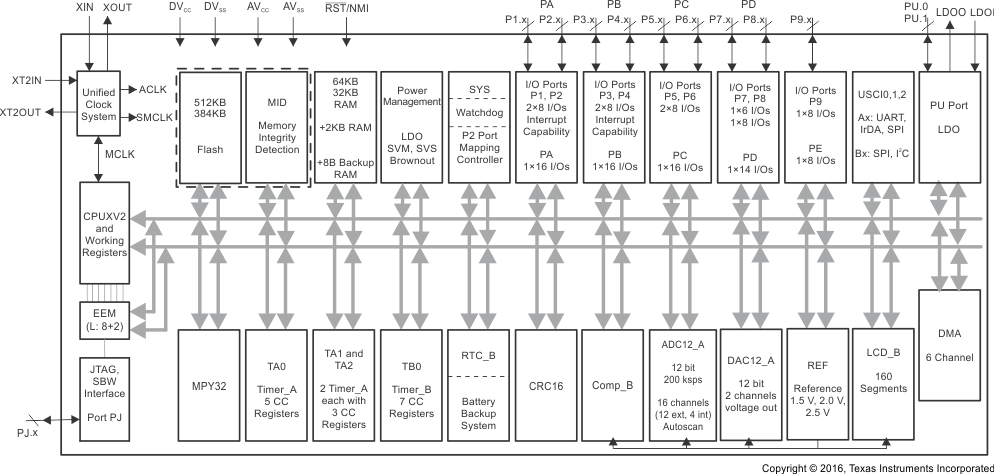ZHCSFC2A August 2016 – August 2016 MSP430F6459-HIREL
PRODUCTION DATA.
- 1器件概述
- 2修订历史记录
- 3Device Comparison
- 4Terminal Configuration and Functions
-
5Specifications
- 5.1 Absolute Maximum Ratings
- 5.2 ESD Ratings
- 5.3 Recommended Operating Conditions
- 5.4 Active Mode Supply Current Into VCC Excluding External Current
- 5.5 Low-Power Mode Supply Currents (Into VCC) Excluding External Current
- 5.6 Low-Power Mode With LCD Supply Currents (Into VCC) Excluding External Current
- 5.7 Schmitt-Trigger Inputs - General-Purpose I/O
- 5.8 Leakage Current - General-Purpose I/O
- 5.9 Outputs - General-Purpose I/O (Full Drive Strength)
- 5.10 Outputs - General-Purpose I/O (Reduced Drive Strength)
- 5.11 Thermal Resistance Characteristics for PZ Package
- 5.12 Typical Characteristics - Outputs, Reduced Drive Strength (PxDS.y = 0)
- 5.13 Typical Characteristics - Outputs, Full Drive Strength (PxDS.y = 1)
- 5.14 Timing and Switching Characteristics
-
6Detailed Description
- 6.1 Overview
- 6.2 CPU
- 6.3 Instruction Set
- 6.4 Operating Modes
- 6.5 Interrupt Vector Addresses
- 6.6 Memory Organization
- 6.7 Bootloader (BSL)
- 6.8 JTAG Operation
- 6.9 Flash Memory
- 6.10 Memory Integrity Detection (MID)
- 6.11 RAM
- 6.12 Backup RAM
- 6.13
Peripherals
- 6.13.1 Digital I/O
- 6.13.2 Port Mapping Controller
- 6.13.3 Oscillator and System Clock
- 6.13.4 Power-Management Module (PMM)
- 6.13.5 Hardware Multiplier (MPY)
- 6.13.6 Real-Time Clock (RTC_B)
- 6.13.7 Watchdog Timer (WDT_A)
- 6.13.8 System Module (SYS)
- 6.13.9 DMA Controller
- 6.13.10 Universal Serial Communication Interface (USCI)
- 6.13.11 Timer TA0
- 6.13.12 Timer TA1
- 6.13.13 Timer TA2
- 6.13.14 Timer TB0
- 6.13.15 Comparator_B
- 6.13.16 ADC12_A
- 6.13.17 DAC12_A
- 6.13.18 CRC16
- 6.13.19 Voltage Reference (REF) Module
- 6.13.20 LCD_B
- 6.13.21 LDO and PU Port
- 6.13.22 Embedded Emulation Module (EEM) (L Version)
- 6.13.23 Peripheral File Map
- 6.14
Input/Output Schematics
- 6.14.1 Port P1, P1.0 to P1.7, Input/Output With Schmitt Trigger
- 6.14.2 Port P2, P2.0 to P2.7, Input/Output With Schmitt Trigger
- 6.14.3 Port P3, P3.0 to P3.7, Input/Output With Schmitt Trigger
- 6.14.4 Port P4, P4.0 to P4.7, Input/Output With Schmitt Trigger
- 6.14.5 Port P5, P5.0 and P5.1, Input/Output With Schmitt Trigger
- 6.14.6 Port P5, P5.2 to P5.7, Input/Output With Schmitt Trigger
- 6.14.7 Port P6, P6.0 to P6.7, Input/Output With Schmitt Trigger
- 6.14.8 Port P7, P7.2, Input/Output With Schmitt Trigger
- 6.14.9 Port P7, P7.3, Input/Output With Schmitt Trigger
- 6.14.10 Port P7, P7.4 to P7.7, Input/Output With Schmitt Trigger
- 6.14.11 Port P8, P8.0 to P8.7, Input/Output With Schmitt Trigger
- 6.14.12 Port P9, P9.0 to P9.7, Input/Output With Schmitt Trigger
- 6.14.13 Port PU.0, PU.1 Ports
- 6.14.14 Port J, PJ.0 JTAG Pin TDO, Input/Output With Schmitt Trigger or Output
- 6.14.15 Port J, PJ.1 to PJ.3 JTAG Pins TMS, TCK, TDI/TCLK, Input/Output With Schmitt Trigger or Output
- 6.15 Device Descriptors
- 7Applications, Implementation, and Layout
- 8器件和文档支持
- 9机械、封装和可订购信息
1 器件概述
1.1 特性
-
低电源电压范围:
1.8V 到 3.6V - 超低功耗
- 工作模式 (AM):
所有系统时钟均工作:
在 8MHz、3V 且闪存程序执行时为 295μA/MHz(典型值) - 待机模式 (LPM3):
看门狗(采用晶振)和电源监控器工作,完全 RAM 保持,快速唤醒:
2.2V 时为 2μA,3V 时为 2.2μA(典型值) - 关断、实时时钟 (RTC) 模式 (LPM 3.5):
关断模式,RTC(采用晶振)工作:
3V 时为 1.1µA(典型值) - 关断模式 (LPM4.5):
3V 时为 0.45µA(典型值)
- 工作模式 (AM):
- 在 3μs(典型值)内从待机模式唤醒
- 16 位精简指令集 (RISC) 架构、扩展存储器、高达 20MHz 的系统时钟
- 灵活的电源管理系统
- 内置可编程的低压降稳压器 (LDO)
- 电源电压监控、监视、和临时限电
- 统一时钟系统
- 针对频率稳定的锁频环路 (FLL) 控制环路
- 低功率低频内部时钟源 (VLO)
- 低频修整内部参照源 (REFO)
- 32kHz 晶体 (XT1)
- 高达 32MHz 的高频晶振 (XT2)
- 4 个定时器,分别配有 3、5 或 7 个捕捉/比较寄存器
- 3 个通用串行通信接口 (USCI)
- USCI_A0,USCI_A1 和 USCI_A2 都支持:
- 具有自动波特率检测功能的增强型通用异步收发器 (UART)
- IrDA 编码器和解码器
- 同步串行外设接口 (SPI)
- USCI_B0,USCI_B1 和 USCI_B2 都支持:
- I2C
- 同步串行外设接口 (SPI)
- USCI_A0,USCI_A1 和 USCI_A2 都支持:
- 具有内部共用基准、采样保持、和自动扫描功能的 12 位模数转换器 (ADC)
- 2 个具有同步功能的 12 位数模转换器 (DAC)
- 电压比较器
- 具有高达 160 段对比度控制的集成 LCD 驱动器
- 硬件乘法器支持 32 位运算
- 串行板上编程,无需外部编程电压
- 6 通道内部直接内存访问 (DMA)
- 具有电源电压后备开关的 RTC 模块
1.2 应用范围
- 模拟和数字传感器系统
- 数字电机控制
- 遥控
- 恒温器
- 数字定时器
- 手持仪表
1.3 说明
TI 的 MSP430™系列超低功耗微控制器种类繁多,各成员器件配备不同的外设集以满足各类应用的 需求。该架构与五种低功耗模式配合使用,是延长便携式测量应用电池寿命的最优 选择。该器件 具有 一个强大的 16 位精简指令集 (RISC) 中央处理器 (CPU),使用 16 位寄存器以及常数发生器,以便获得最高编码效率。该数控振荡器 (DCO) 可在 3µs(典型值)内从低功率模式唤醒至激活模式。
MSP430F6459-HIREL 微控制器配有一个集成式 3.3V LDO、四个 16 位定时器、一个高性能 12 位 ADC、三个 USCI、一个硬件乘法器、DMA、具有报警功能的 RTC 模块、一个比较器和多达 74 个 I/O 引脚。
这些 器件 的典型应用包括模拟和数字传感器系统、数字电机控制、遥控、恒温器、数字定时器以及手持仪表。
